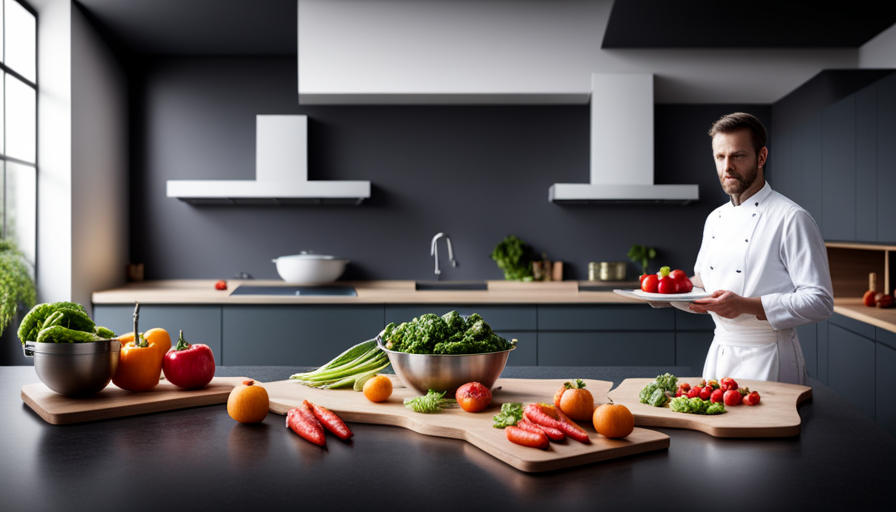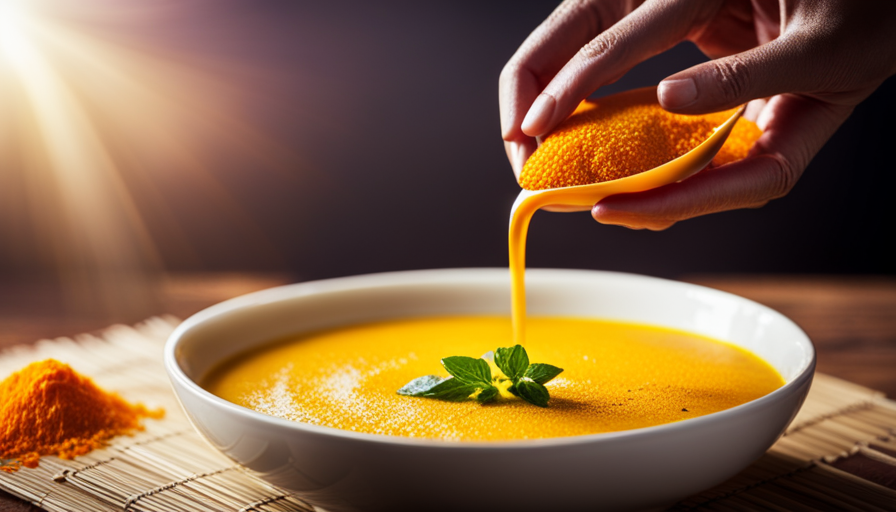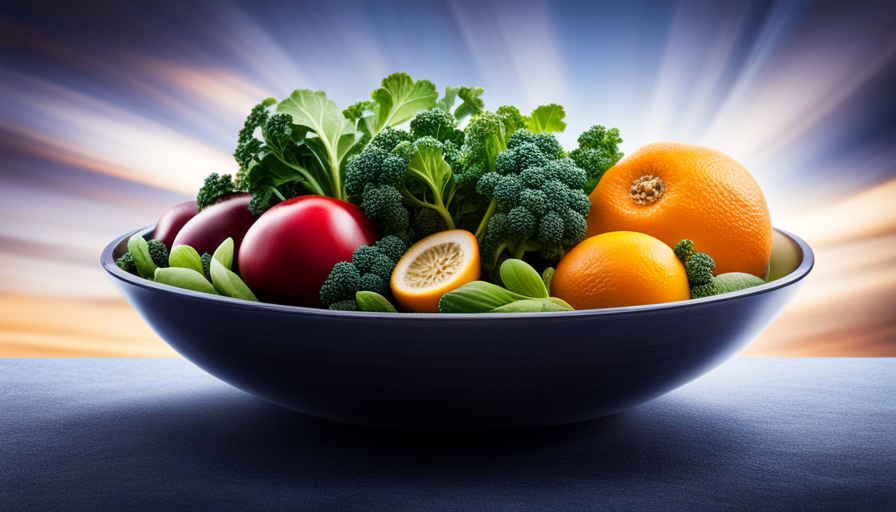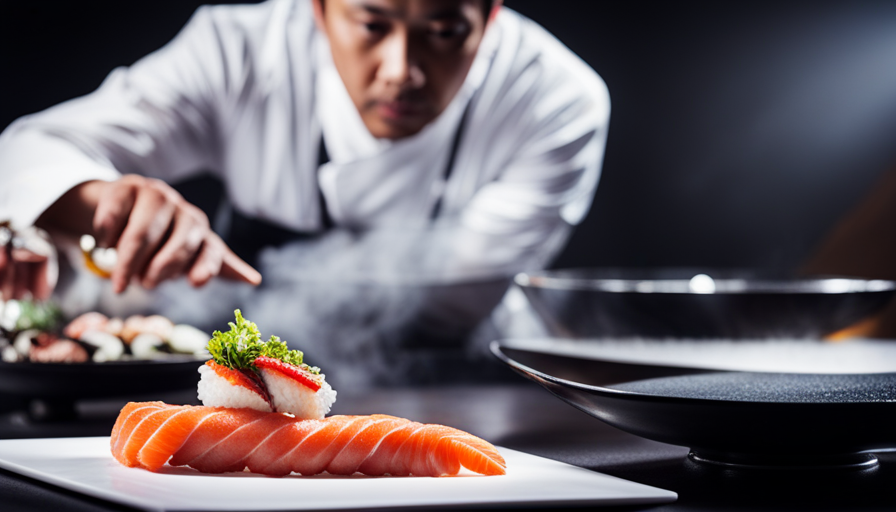Having trouble with raw cuisine? It’s time to discover the world of warming up raw dishes! Just because your meals are uncooked doesn’t mean they have to be cold.
In fact, there are plenty of ways to add warmth and flavor to your raw meals. So, let’s turn up the heat and explore some creative ways to heat up raw food.
In this article, we will show you how to transform your raw ingredients into delicious, warm dishes that will satisfy your cravings. From using a blender to create creamy and comforting soups, to sautéing raw ingredients for that extra burst of flavor, we’ve got you covered.
You’ll also discover the magical powers of a dehydrator for creating warm and crispy snacks, as well as the art of boiling raw grains and legumes for a cooked alternative.
So, whether you’re a raw food enthusiast looking to switch things up or simply curious about incorporating more warmth into your meals, this article is for you. Get ready to heat things up and elevate your raw food game to a whole new level.
Key Takeaways
- Blending raw ingredients in a blender can create creamy and comforting soups, such as tomato soup, avocado soup, and carrot and ginger soup.
- Steaming vegetables retains their natural flavors and nutrients, making it a great way to add warmth to raw meals.
- Sautéing raw ingredients in a pan enhances their flavors and creates a golden-brown crust, adding warmth to the dish.
- Using a dehydrator can make warm and crispy snacks without the need for added oils, providing a tasty option for heating up raw food.
Using a Blender for Raw Soups
Using a blender for raw soups adds a smooth and velvety texture that enhances the overall taste and experience of the dish. Blender recipes are a great way to create delicious and nutritious raw soups.
There are numerous raw soup ideas that can be easily made using a blender.
One popular recipe is the classic tomato soup. Simply blend together ripe tomatoes, cucumber, red bell pepper, celery, and a dash of olive oil. This combination creates a refreshing and tangy soup that is perfect for a light lunch or dinner.
Another tasty option is a creamy avocado soup. Blend together ripe avocados, cucumber, spinach, garlic, lemon juice, and a pinch of salt. The result is a rich and creamy soup that is packed with healthy fats and nutrients.
If you’re looking for something with a little more kick, try a spicy carrot and ginger soup. Blend together carrots, ginger, garlic, vegetable broth, and a touch of cayenne pepper. This soup is not only delicious but also has anti-inflammatory properties thanks to the ginger.
Using a blender for raw soups opens up a world of possibilities. From classic tomato soup to creamy avocado soup and spicy carrot and ginger soup, there are endless blender recipes to explore and enjoy.
Steaming Vegetables for a Cooked Texture
To achieve a tender and cooked texture, you can steam your vegetables, which will transform them into a delightful and flavorful dish. Steaming is one of the most popular cooking techniques for vegetables as it helps retain their natural flavors and nutrients.
Here’s how you can steam your vegetables to perfection:
-
Begin by selecting fresh and vibrant vegetables. Opt for vegetables like broccoli, carrots, cauliflower, and asparagus, which are perfect for steaming due to their sturdy texture.
-
Wash the vegetables thoroughly under cool water to remove any dirt or debris. Trim the ends and cut them into even-sized pieces to ensure even cooking.
-
Place a steamer basket in a pot filled with a small amount of water. The water should be just below the basket. Bring the water to a boil.
-
Add the vegetables to the steamer basket, making sure they are evenly spread out. Cover the pot with a lid and steam the vegetables for about 5-8 minutes, depending on the desired level of tenderness.
Steaming vegetables not only preserves their natural flavors but also retains more nutrients compared to other cooking methods like boiling or frying. It’s a healthy and delicious way to enjoy your vegetables while enhancing their flavor profiles.
Sautéing Raw Ingredients for Added Flavor
For an explosion of flavor in your dishes, why not sauté your ingredients? You’ll be amazed at how the sizzling and aromatic process can elevate the taste of your meal.
Sautéing is a cooking technique that involves cooking food quickly in a hot pan with a small amount of oil or fat. This method not only helps to heat up raw ingredients but also enhances their flavors.
To sauté raw ingredients, start by heating a pan over medium-high heat. Add a small amount of oil or butter to the pan and let it melt or heat up. Then, add your raw ingredients, such as diced vegetables, sliced meat, or seafood, to the hot pan. Stir or toss the ingredients frequently to ensure even cooking and to prevent them from sticking to the pan.
Sautéing allows the natural sugars in the ingredients to caramelize, creating a delicious golden-brown crust and enhancing their flavors. The high heat also helps to develop a rich, savory taste and a slightly crispy texture. You can further enhance the flavors by adding spices, herbs, or sauces during the sautéing process.
Overall, sautéing is a fantastic technique to heat up raw ingredients while adding depth and complexity to their flavors. Give it a try and experience the delightful transformation of your dishes.
Using a Dehydrator for Warm and Crispy Snacks
Get ready to enjoy warm and crispy snacks with a dehydrator – it’s a game-changer!
When it comes to heating up raw food, using a dehydrator is a fantastic option that can give you that perfect combination of warmth and crispiness. Here are five reasons why using a dehydrator for warm and crispy snacks is a great idea:
-
Retains nutrients: Unlike other heating methods, a dehydrator preserves the nutrients in your food, ensuring that you get all the goodness without compromising on taste.
-
Even heating: Dehydrators distribute heat evenly, ensuring that your snacks are warmed up thoroughly and consistently.
-
No added oils: With a dehydrator, there’s no need to add any oils or fats to achieve that irresistible crispiness. You can enjoy guilt-free snacking!
-
Versatile: Dehydrators can be used for a wide range of snacks, from fruits and vegetables to nuts and seeds. You can get creative and experiment with different flavors and textures.
-
Time-saving: While using an oven or a microwave can be quick and convenient, a dehydrator requires minimal effort. Simply place your raw food inside, set the temperature and time, and let it do its magic.
So, if you’re looking for a quick and easy way to warm up your raw food, consider using a dehydrator. It’s a fantastic tool that can elevate your snacking experience while keeping it healthy and delicious.
Boiling Raw Grains and Legumes for a Cooked Alternative
Picture this: you toss those raw grains and legumes into a pot of boiling water, and before you know it, they transform into a hearty and cooked alternative that’ll satisfy your cravings.
Boiling raw grains and legumes is one of the simplest and most common cooking techniques to heat up raw food. Not only does it provide a warm and comforting meal, but it also unlocks the nutritional benefits hidden within these ingredients.
When you boil raw grains and legumes, the heat and moisture break down their tough outer layers, making them easier to digest. This cooking method also helps to soften the texture and enhance the flavors of the grains and legumes.
Furthermore, boiling can increase the bioavailability of certain nutrients, making it easier for your body to absorb and utilize them.
Additionally, cooking grains and legumes in boiling water can help eliminate any potential harmful bacteria or toxins that may be present. It ensures that your meal is safe to consume and reduces the risk of foodborne illnesses.
Incorporating boiled raw grains and legumes into your diet can provide a rich source of fiber, protein, vitamins, and minerals. They’re versatile ingredients that can be used in various dishes, such as soups, stews, salads, and side dishes.
So next time you’re looking for a cooked alternative to your raw food, consider boiling grains and legumes for a nutritious and delicious meal.
Baking Raw Desserts for a Warm and Indulgent Treat
Indulge in the warm and comforting goodness of baked raw desserts for a truly decadent treat. Baking raw desserts not only adds a delightful warmth, but it also enhances the flavors and textures of the ingredients.
To create these delectable treats, you’ll need to master some baking techniques and have a collection of raw dessert recipes on hand.
When baking raw desserts, it’s important to understand that the absence of traditional baking ingredients like flour and eggs requires some creativity. Instead, you can use a combination of nuts, seeds, and dried fruits as the base for your desserts. These ingredients provide moisture and binding properties, allowing you to achieve the desired texture.
One popular technique for baking raw desserts is to use a dehydrator. This appliance gently dries out the desserts while maintaining their raw integrity. It helps to retain the enzymes and nutrients present in the ingredients, making the desserts not only delicious but also nutritious.
Raw dessert recipes are abundant online and in cookbooks dedicated to the raw food lifestyle. From raw brownies and cheesecakes to fruit tarts and cookies, the options are endless. Experiment with different flavors and ingredients to find your favorite combination.
So, next time you’re craving a warm and indulgent treat, try baking a raw dessert. With the right techniques and recipes, you can enjoy the goodness of a decadent dessert while staying true to your raw food lifestyle.
Using a Hot Water Bath to Warm Raw Sauces and Dips
Immerse your raw sauces and dips in a steaming hot water bath to infuse them with warmth and create a luscious, velvety texture. While baking raw desserts is a popular method to warm up raw food, using a hot water bath is an excellent alternative for raw sauces and dips. This method is simple and effective, allowing you to maintain the raw integrity of your ingredients while still enjoying a warm and comforting dish.
There are different methods you can use to warm your raw sauces and dips with a hot water bath. One way is to place your sauce or dip in a heat-safe container and then submerge it in a larger bowl filled with hot water. Make sure the water is hot but not boiling, as excessive heat can affect the quality of your raw food. Stir the sauce or dip occasionally to ensure even heating.
Another option is to use a double boiler. This involves placing your sauce or dip in a heat-safe bowl, which is then set over a pot of simmering water. The steam from the water will gently warm your sauce or dip without direct heat. Stirring occasionally will help distribute the warmth evenly.
Using a hot water bath is a versatile and gentle method for warming raw sauces and dips. It allows you to maintain the raw qualities of your ingredients while adding a comforting touch of warmth. Experiment with different techniques to find the one that works best for you and enjoy your delicious, warmed-up creations.
Grilling Raw Vegetables for a Smoky Flavor
Get ready to elevate your raw vegetable dishes to the next level by grilling them to perfection, infusing them with a delightful smoky flavor. Grilling raw vegetables not only adds a unique taste but also brings out their natural sweetness and enhances their texture.
Here are some grilling techniques and marinade options to make your grilled vegetables truly irresistible:
-
Preparing the vegetables: Start by choosing firm and fresh vegetables like bell peppers, zucchini, eggplant, and corn. Cut them into even-sized pieces to ensure even cooking. Brush the vegetables lightly with olive oil to prevent sticking and season with salt and pepper.
-
Direct grilling: This technique involves placing the vegetables directly on the grill grates over medium-high heat. It works best for small and firm vegetables like cherry tomatoes and mushrooms. Remember to turn the vegetables occasionally to achieve even charring.
-
Indirect grilling: For larger vegetables like eggplant and zucchini, indirect grilling is recommended. This technique involves placing the vegetables on a cooler part of the grill and cooking them with the lid closed. It allows for slower cooking and prevents excessive charring.
Marinade options: Marinating the vegetables before grilling can enhance their flavor. You can use a variety of marinades like balsamic vinegar, soy sauce, garlic, and herbs. Let the vegetables marinate for at least 30 minutes before grilling to allow the flavors to penetrate.
With these grilling techniques and marinade options, you can transform ordinary raw vegetables into a smoky, flavorful delight that will impress your taste buds and elevate your dishes to a whole new level. So fire up the grill and get ready to savor the deliciousness!
Using a Slow Cooker for Tender and Flavorful Raw Meals
Discover the magic of using a slow cooker to effortlessly create tender and flavorful meals from your fresh ingredients. Slow cookers, also known as crock-pots, have become a staple in many kitchens due to their convenience and ability to enhance the taste and texture of raw meals.
One of the main benefits of using a slow cooker is that it allows you to cook your food at a low temperature over a longer period of time, resulting in tender and juicy meats, and perfectly cooked vegetables. The slow cooking process also helps to retain the natural flavors of the ingredients, making your meals more flavorful.
When it comes to raw meals, slow cookers offer a wide range of possibilities. You can use them to make delicious soups, stews, and casseroles by simply adding your raw ingredients and allowing them to cook slowly throughout the day. Slow cooker recipes are abundant and diverse, ranging from hearty beef chili to creamy chicken and mushroom pasta.
The best part is that you can simply set it and forget it, allowing you to go about your day while your meal slowly cooks to perfection.
Utilizing a slow cooker is a fantastic way to transform your raw ingredients into tender and flavorful meals. The benefits of using a slow cooker, such as convenience and enhanced taste, make it an essential tool in any kitchen.
With a wide range of slow cooker recipes available, you can easily find something that suits your taste preferences and dietary needs. So go ahead, dust off your slow cooker and start enjoying the delicious and effortless meals it can create.
Incorporating Spices and Seasonings to Add Warmth to Raw Dishes
If you’re looking to add a little warmth and depth of flavor to your raw dishes, incorporating spices, herbs, and seasonings is a fantastic way to achieve that. Not only do these ingredients enhance the taste of your raw meals, but they also bring a comforting and cozy element to them.
By exploring different cooking techniques, you can create warmth in your raw food. One way to do this is by utilizing spices such as cinnamon, cumin, or paprika, which can add a subtle heat and earthiness to your dishes. Herbs like thyme, rosemary, or oregano can also contribute to the overall warmth and complexity of flavors.
To help you better understand the different spices, herbs, and seasonings that can be used to enhance the flavor of your raw dishes, here’s a handy table:
| Spice/Herb/Seasoning | Flavor Profile | Best Used In |
|---|---|---|
| Cinnamon | Warm and sweet | Desserts |
| Cumin | Earthy and smoky | Middle Eastern or Mexican cuisine |
| Paprika | Mild and slightly sweet | Soups or stews |
| Thyme | Woody and aromatic | Roasted vegetables or meat substitutes |
| Rosemary | Piney and fragrant | Grilled dishes |
| Oregano | Herbal and slightly bitter | Italian or Mediterranean cuisine |
By incorporating these spices, herbs, and seasonings into your raw dishes, you can elevate their flavor and create a warm and comforting experience for your taste buds. So go ahead, experiment with different combinations and techniques to make your raw meals truly delicious.
Frequently Asked Questions
Can I use a blender to heat up raw soups if I don’t have a stove?
If you don’t have a stove, using a blender to heat up raw soups isn’t recommended. Blenders aren’t designed to generate heat, so they won’t be able to heat your food. Instead, consider alternative methods like using a microwave, slow cooker, or an immersion blender with a heating function. When working with raw food, it’s important to prioritize food safety. Make sure to follow proper food handling and cooking techniques to prevent any risk of foodborne illness.
How long should I steam vegetables to achieve a cooked texture?
To achieve a cooked texture when steaming vegetables, it’s important to follow proper steaming techniques. Start by cutting the vegetables into uniform sizes to ensure even cooking. Place them in a steamer basket over boiling water and cover with a lid.
The cooking time will vary depending on the type and size of the vegetables. Generally, steaming vegetables takes around 5-10 minutes, but denser vegetables like potatoes may take longer. It’s best to check for doneness by testing with a fork or tasting.
Can sautéing raw ingredients really add flavor to my dish?
Sautéing raw ingredients can indeed add a burst of flavor to your dish. By marinating the raw ingredients before sautéing, you allow the flavors to penetrate the food, resulting in a more delicious outcome.
However, roasting raw ingredients can also enhance the flavor, as it brings out the natural sweetness and adds a caramelized touch. Both methods have their benefits, so it ultimately depends on the taste you’re aiming for.
How long does it take to dehydrate snacks in a dehydrator?
Dehydration time for snacks in a dehydrator can vary depending on the type of food and desired level of dryness. On average, most snacks take between 6 to 12 hours to dehydrate fully. Thinly sliced fruits and vegetables tend to dehydrate faster than meat or thicker pieces.
It’s important to follow the specific instructions for your dehydrator and regularly check the snacks for desired texture and moisture content.
Can I boil raw grains and legumes as a substitute for cooking them?
Boiling raw grains and legumes is a suitable substitute for cooking them. When boiling grains, such as rice or quinoa, you can achieve a similar result as cooking them by simmering them in water until they become tender.
Boiling legumes, like lentils or chickpeas, helps soften them, making them easier to digest and reducing cooking time. Additionally, boiling legumes helps to remove anti-nutrients, like phytic acid, making them more nutritious and easier to absorb.
What is the Best Method to Heat Up Raw Food Without Exceeding 118 Degrees?
When it comes to heating raw food correctly, using a dehydrator is considered the best method to maintain a temperature below 118 degrees Fahrenheit. This gentle heat preserves the food’s nutrients and enzymes, making it an ideal way to warm up raw meals without exceeding the recommended temperature.
Conclusion
In conclusion, heating up raw food doesn’t have to be complicated. By incorporating various cooking methods and techniques, you can transform raw ingredients into warm and flavorful dishes.
Whether it’s using a blender for soups, steaming vegetables for a cooked texture, or sautéing raw ingredients for added flavor, there are plenty of options to choose from.
Don’t be afraid to experiment with different spices and seasonings to add warmth and depth to your raw meals. Remember, Rome wasn’t built in a day, so take your time and enjoy the process of creating nourishing and delicious dishes.
Happy cooking!










